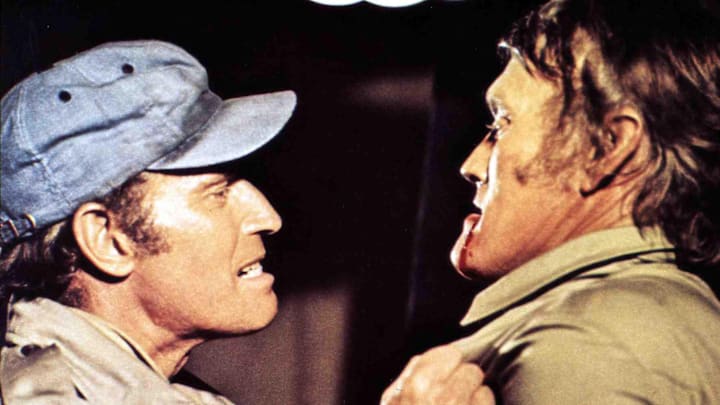Science fiction has always been a genre where authors can peer into the future—sometimes with alarming prescience. That holds true for Soylent Green, a 1973 feature film based on the novel Make Room! Make Room! by Harry Harrison. In the year 2022, overpopulation and climate change hammer humanity; those living in poverty have to rely on food supplements, while the elite loom over them in high rises. New York police detective Robert Thorn (Charlton Heston) investigates the murder of one such elite: a board member of the Soylent food corporation.
Now that we’re living in the year the film anticipated, did Soylent Green get anything right? The answer, unfortunately, is yes, though thankfully not all its dystopian ideas came true.
1. Right: Climate Change
The opening scene of Soylent Green provides some blunt but necessary exposition. After waking, Thorn banters with his friend and roommate Sol Roth (Edward G. Robinson). After Thorn turns up his nose at spoiled margarine, Roth complains of the oppressive, year-round heat and “the greenhouse effect.”
While winter hasn’t abandoned the world just yet, things are getting markedly hotter. The summer of 2022 saw record temperatures hit the Northeast. Boston reached 98°F; Albany hit 99°F. In New York, it rose to 93°F, though that wasn’t close to the record of 100°F set that day in 1944. Heat emergencies were declared in Philadelphia, Washington, and Boston. On the West Coast, a heat dome suffocated parts of California, Oregon, and Washington State in temperatures well over 100°F. A report from the UN’s Intergovernmental Panel on Climate Change warned that high emissions from fossil fuels could allow global warming to continue unchecked.
2. Right: Meal Replacements
The Soylent Green of the title refers to a “high energy vegetable concentrate,” a tasteless source of nutrition for a world where unprocessed food is in very short supply. (Soylent is scarce, too: When the precious stuff is distributed, riots nearly break out.) While it’s not exactly necessary for most healthy people to ingest nutritional supplements, a vast array of protein shakes, bars, and other meal replacements is now a regular part of the American diet. Roughly half of the country consumes protein shakes regularly. In a truly ironic twist, a company called Soylent markets a ready-to-drink plant protein product (also called Soylent) that found a fan base among tech bros and busy professionals who don’t want to cook.
3. Half-Right: People Hired as “Furniture”
When Thorn is called to investigate the suspicious death of wealthy William Simonson at the victim’s home, he meets a young woman named Shirl, who introduces herself as “furniture”—a companion for rich tenants provided by the apartment building. It’s implied Shirl may be a sexual partner for Simonson, but they also seem like friends (despite the obviously sexist power dynamic).
In Japan, it’s possible to hire a surrogate—a person who can pretend to be a friend or family member at weddings, baby showers, high-school reunions, and more. One surrogate, dubbed “Mr. Rental,” shares meals and listens to clients as they talk about their lives.
4. Right: Shortages of Consumer Goods
When Thorn strolls through Simonson’s apartment, he’s amazed to discover a variety of amenities that are difficult to come by. He’s most impressed with a bar of soap and cold water. Later, he covets ice cubes, cigarettes, and a spoonful of strawberry jam, which runs $150 a jar.
Thanks to the coronavirus pandemic, consumers have had a hard time locating everything from toilet paper to Choco Tacos. When they do come across one of these treasures, inflated price tags go along with the items. Supply chain issues have also affected the availability of baby formula, gas, and almost anything manufactured overseas. Even before the pandemic, consumers faced a brief shortage of Dawn dish soap.
The shortages lead to angry mobs in Soylent Green. Shortages in the real world haven’t sparked mass demonstrations, though there have been isolated reports of shoppers getting physical over empty shelves.
5. Right: Motivational Exercise Bikes
During the pandemic, home fitness enthusiasts flocked to companies like Peloton, which offer stationary exercise equipment married to some kind of motivational tool—typically a screen with an effusive workout coach beaming in from an online studio. There’s an exercise bike in Soylent Green, too, but the motivation isn’t toning up. It’s so Sol Roth can generate electricity in their shared apartment.
6. Wrong: New York City’s Population
Many of the troubles endured by the characters in Soylent Green are attributed to human overpopulation. In the opening moments of the film, a legend appears informing the viewer that New York City is home to 40 million residents. In 2022, the population in the city is just shy of 9 million.
7. Wrong: The Unemployment Rate
Thorn makes an off-handed comment that there are “20 million guys out of work” in Manhattan, putting the area’s unemployment rate at 50 percent or more. In July 2022, the actual unemployment rate in New York City was at a far more reasonable 6.1 percent. But that figure was still higher than the U.S. rate of 3.5 percent that month.
8. Half-Wrong: Cannibalism
Even if you’ve never seen Soylent Green, you’ve probably heard of the film’s Twilight Zone-esque ending [SPOILER ALERT!]: The processed food replacement Soylent is made of people.
While this kind of cannibalism comes as a huge surprise to Thorn, there haven’t been any similar discoveries with our food supply IRL. But as The New York Times recently observed, cannibalism seems to be having a “moment” in 2022. It’s a topic in novels like Tender Is the Flesh, the movie Fresh, the Showtime series Yellowjackets, and, um, the docuseries House of Hammer. Soylent Green may not have anticipated actual cannibalism, but American culture seems to be consuming a lot of media about it.
